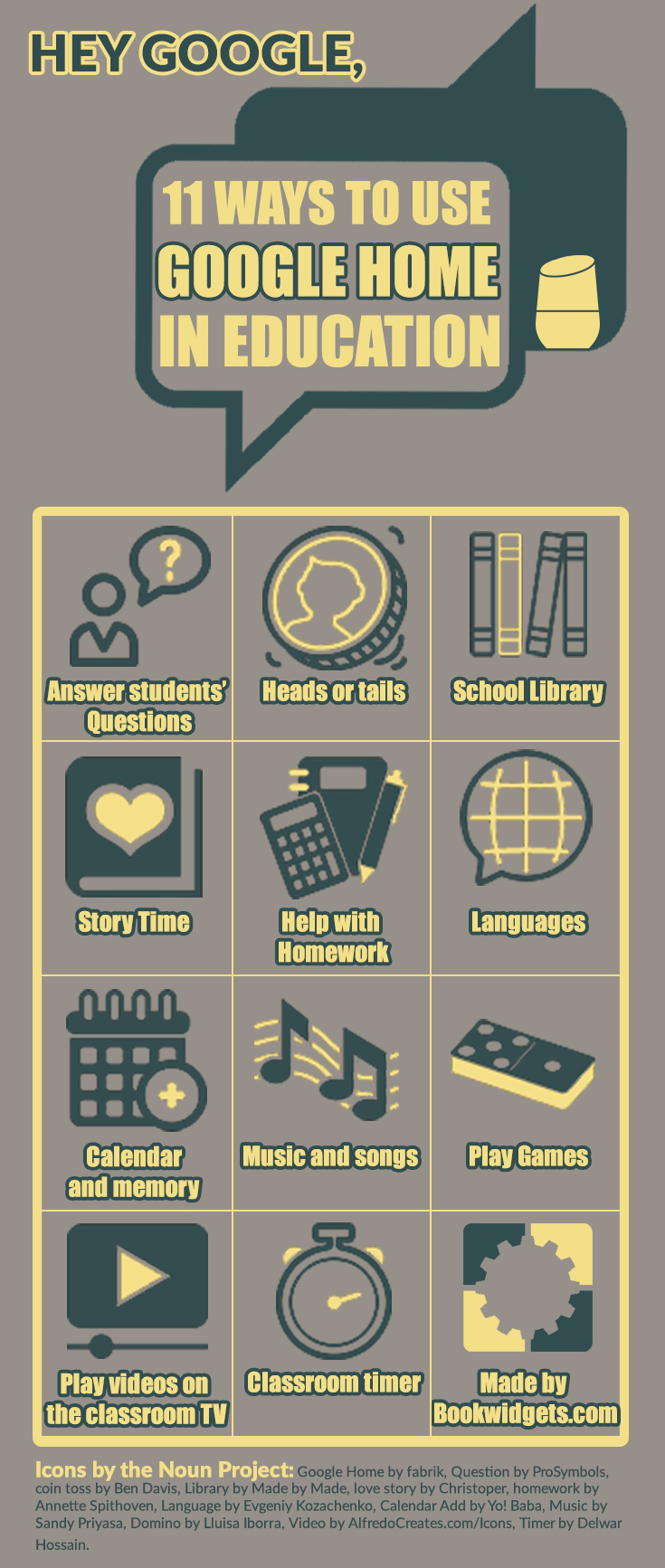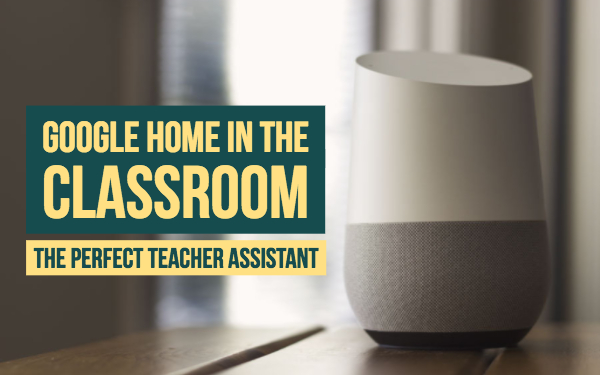Google Home in the classroom - The perfect teacher assistant
 Lucie Renard —
Lucie Renard —
My boyfriend bought a Google Home last year. As I just went along with it, the cool new speaker is now supplementing my grocery list, amusing us with jokes I don’t get and telling me the time.
So I thought, since it’s my new buddy, how could a teacher use an assistant like this in his or her classroom?
I can only imagine the wonders it can do for teachers and students. How many times did your students ask you something you didn’t know the answer to? Or how many times you said to look it up by next class, and you actually forgot to look it up - hoping that the student won’t bring it up again? Google Home could help you out!
In this blog post I’ll talk about using Google Home in the classroom. I’ll show you the different ways on how you could use it and some benefits of installing a Google Home assistant in your classroom.
11 Ways to use Google Home in education
In order to get the Google Assistant to help you, you have to say something first. Start by using the words “Hey Google” or “Okay Google”. Then, ask something.
1. Answer students' questions
 Do your students have too many questions, or is there something you simply don’t know? Let them ask Google just anything. Your assistant will give them the answer, or send over some information to your connected phone. Here are some examples:
Do your students have too many questions, or is there something you simply don’t know? Let them ask Google just anything. Your assistant will give them the answer, or send over some information to your connected phone. Here are some examples:
- How many bones does the human body have?
- When is the next full moon?
- What’s the population of …?
- Who invented…?
- Who is Leonardo Da Vinci?
- What’s the capital of…?
2. Heads or tails
 Let Google choose heads or tails to find out who begins. Google can even roll the dice for you during an educational board game. Dices come in handy from time to time. This one, you won’t lose eventually.
Let Google choose heads or tails to find out who begins. Google can even roll the dice for you during an educational board game. Dices come in handy from time to time. This one, you won’t lose eventually.
3. School Library
 Put a Google Home assistant in your school’s library. It will help students with questions about books, authors, titles and so on.
Put a Google Home assistant in your school’s library. It will help students with questions about books, authors, titles and so on.
Here are some question examples, students can ask Google.
- Ask about authors: What books did … write? Who is…? What’s the most popular book of…?
- Ask about book series: What’s the second book in The Harry Potter series?
- Ask about book titles: Who’s the author of…? What’s … about? To what genre does … belong?
- Book recommendations: “What books would you recommend for a … year old?”
4. Story time
 Ask Google Home to tell a story. Just a random story or a real fairy tale. Think out some questions for your students to answer when the story’s done. This could be a great listening exercise!
Ask Google Home to tell a story. Just a random story or a real fairy tale. Think out some questions for your students to answer when the story’s done. This could be a great listening exercise!
Using a Google Home assistant in elementary school or kindergarten? Build a cosy story corner, where students can sit and listen to amazing stories, told by the Google teaching Assistant.
5. Help with homework
 Do your students need help with their homework or assignments and you’re helping out someone else already? Your teaching assistant will take over and respond to “Okay Google, help me with my homework”. Or just ask immediately for a solution to your question.
Do your students need help with their homework or assignments and you’re helping out someone else already? Your teaching assistant will take over and respond to “Okay Google, help me with my homework”. Or just ask immediately for a solution to your question.
- For math: Hey Google, what’s the square root of 888?”
- For history “Hey Google, who founded the European Union?”
- For geography: “Hey Google, what’s the capital of Belgium?”
- For physics: “Hey Google, what’s ‘quantum theory’?”
These are just some examples. There are just so many question you could ask.
6. Languages
 As I’ve just told you, Google Home can help students with homework and assignments. There are some more incredible things your assistant can do, especially for languages.
As I’ve just told you, Google Home can help students with homework and assignments. There are some more incredible things your assistant can do, especially for languages.
- Translate words to another language: “Hey Google, what’s the Dutch word for Frog?”
- Spell words: “Hey Google, how do you spell ‘emancipation’?”
- Get a better sense of the pronunciation: “Hey Google, how do you pronounce, reception?”
7. Personal calendar and memory
 As a teacher, you have a lot of things on your head. Most of the time you think about 9 things, but forget the last one. Ask your assistant to help you out and remember it for you. Use these magical words: “Hey Google, remember to send a mail to the principal about the excursion.” When you ask Google later on, use the words “Hey Google, what did I need to remember?”.
As a teacher, you have a lot of things on your head. Most of the time you think about 9 things, but forget the last one. Ask your assistant to help you out and remember it for you. Use these magical words: “Hey Google, remember to send a mail to the principal about the excursion.” When you ask Google later on, use the words “Hey Google, what did I need to remember?”.
Google Home also lets you access your calendar. Simply ask “Hey Google, what meetings do I have today?” You can also add events to your calendar by asking “Hey Google, add a meeting with Ruby tomorrow at 15 PM to my calendar.”
8. Music and songs
 Want to play some background music, when students are working on an assignment or working in groups? Just ask Google. Your assistant can turn on a radio station, or play a particular song. It can also start a playlist from Spotify when connected.
Want to play some background music, when students are working on an assignment or working in groups? Just ask Google. Your assistant can turn on a radio station, or play a particular song. It can also start a playlist from Spotify when connected.
Rather want to entertain students with music and funny sounds? Ask Google to sing a song or ask what a train sounds like.
9. Play games
 A dead moment in class or in need of an energizer? Google Home has lots of fun games you can play with your students. Try out some of these fun games. Google gets crazy sometimes and you’ll be surprised by what Lucky Trivia can teach your students.
A dead moment in class or in need of an energizer? Google Home has lots of fun games you can play with your students. Try out some of these fun games. Google gets crazy sometimes and you’ll be surprised by what Lucky Trivia can teach your students.
- “Hey Google, Let’s play a game.”
- “Hey Google, Mad Libs”
- “Hey Google, Play lucky Trivia.”
10. Play videos on the classroom TV
 If you have a Google Chromecast plugged into the classroom TV, you can ask to watch content through Google Home. For instance, you can say “Hey Google, show me videos about ‘the sales conversation’ from YouTube.’ Or “Hey Google, show me photos of the human body”. Be careful with that last one! 😉 It will show you pictures that come up on Google Photos.
If you have a Google Chromecast plugged into the classroom TV, you can ask to watch content through Google Home. For instance, you can say “Hey Google, show me videos about ‘the sales conversation’ from YouTube.’ Or “Hey Google, show me photos of the human body”. Be careful with that last one! 😉 It will show you pictures that come up on Google Photos.
11. Classroom timer
 Ask Google the time or set an alarm in 10 minutes. All is possible. This way, students have a certain amount of time to complete the assignment before reviewing it. It’s a personal timekeeper so you’re always right on schedule!
Ask Google the time or set an alarm in 10 minutes. All is possible. This way, students have a certain amount of time to complete the assignment before reviewing it. It’s a personal timekeeper so you’re always right on schedule!
The benefits of using a Google Home assistant in your classroom
- The first one is definitely the price. For only 129$ you have a full-time personal know-all teaching assistant.
- You have a great excuse to “not know” things. Students will be thrilled when you use the phrase “Let’s ask Google!”. Of course, this doesn’t mean you can get lazy. You still have to know what you’re teaching.
- It’s a quick way to move to the right subject and to evade endless discussions about lesson topics. Google knows, you know…
- It teaches students to form good questions.
- It can be used as a connection between devices, sending back and forth information and enabling devices without even touching them. Your classroom is magically connected.
Attention! It’s still Google. It’s still the internet. There’s still fake news. Not everything Google says is exactly true. Google collects information from good ranking webpages and its own search history.
Setting up Google Home in your classroom
I can hear you thinking: “uhm, technology, connections, devices? ….pffff.” Don’t worry. Setting up your own Google Home teaching assistant takes much less time than hiring a real one. It has some steps to be completed, but it’s very simple. Learn it here.



